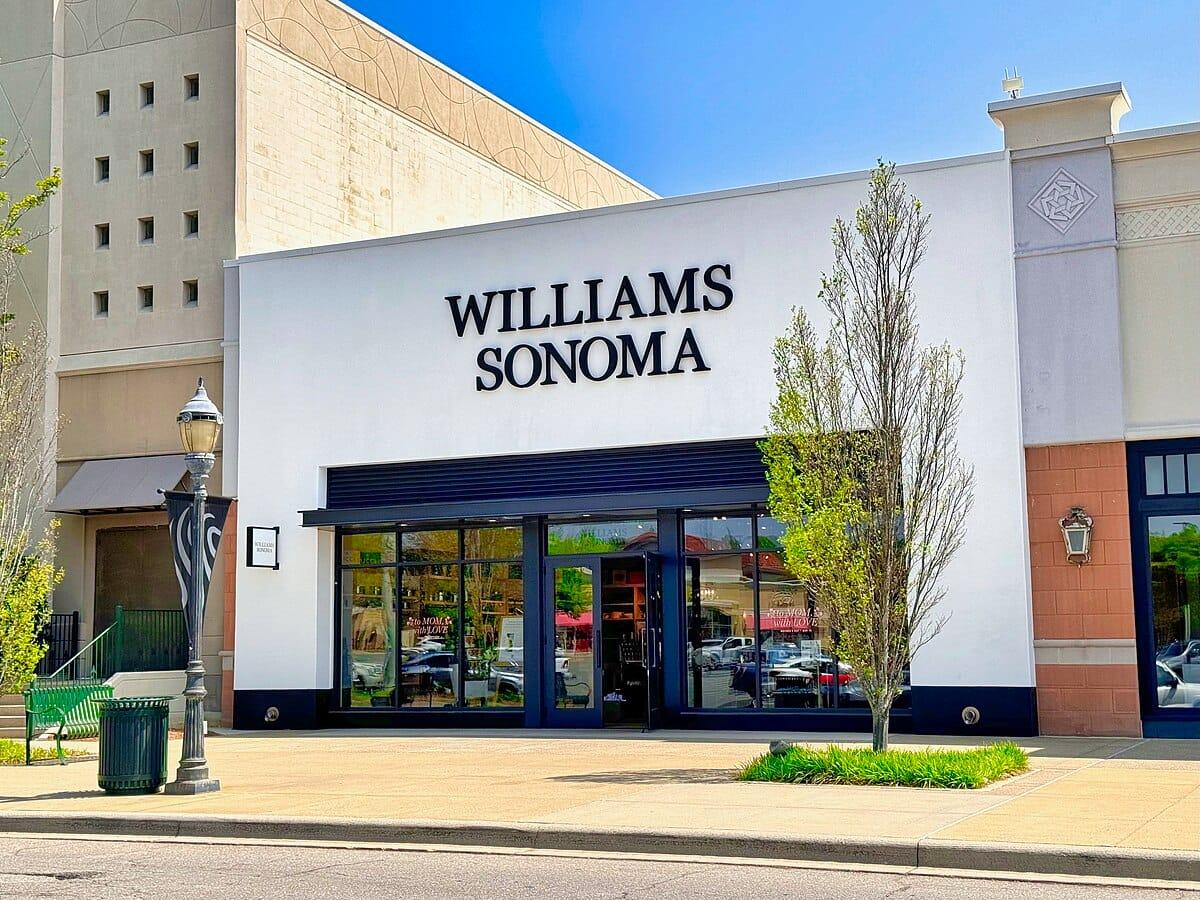The Origin of the Williams-Sonoma Brands Pottery Barn and West Elm
Williams-Sonoma started as a small cookware shop in 1956, founded by Chuck Williams. It grew into a major home goods brand by expanding into furniture with Pottery Barn and launching West Elm, all while staying true to its commitment to quality and innovation.

If you’ve ever cooked a meal or decorated your home, you’ve probably come across Williams-Sonoma. But how did this company grow from a small cookware store to one of the biggest names in home furnishings? The story of Williams-Sonoma is one of curiosity, smart decisions, and a relentless commitment to quality.

A Carpenter in Sonoma: Chuck Williams’s Vision
Chuck Williams’s journey started long before he opened his famous store. In 1947, he moved to Sonoma, California, with the simple idea of building homes. He worked as a contractor, but his life would soon take a different turn. Chuck had a passion for cooking and a group of friends who shared that love. Their gatherings became more frequent, and Chuck’s fascination with kitchen tools grew.
In 1953, Chuck and a few of his cooking friends took a trip to Europe that would change his life. It was in Paris where Chuck discovered cookware unlike anything he’d ever seen in the U.S. He was mesmerized by the tools—omelet pans, soufflé molds, and copper pots—that were standard in French kitchens but rare in American homes. Chuck returned from that trip with a new dream: to bring high-quality kitchen tools to the U.S.

The First Store: A Small Shop with Big Dreams
Inspired by his trip, Chuck decided to switch gears. In 1954, he bought a hardware store in downtown Sonoma and began converting it into a kitchen store. By 1956, the first Williams-Sonoma store was born. Chuck filled the shelves with French cookware—copper pans, chef's knives, and baking molds—that he believed would change the way Americans cooked.
The shop was small, but Chuck’s eye for quality and his belief that Americans would embrace these tools quickly attracted attention. His first customers were often curious locals or San Franciscans who’d heard about the little store specializing in exotic cookware. Chuck was onto something bigger than he imagined.
Moving to San Francisco: Reaching a Bigger Audience
In 1958, Chuck decided to move the store to San Francisco to reach more people. He found a spot just blocks away from Union Square, the heart of the city’s shopping district. The location proved to be a smart choice. The store became a hit among passersby, many of whom would stumble upon it while running errands. This growing customer base helped put Williams-Sonoma on the map.
The First Catalog: Reaching America’s Kitchens
By the 1970s, Williams-Sonoma was growing, and Chuck was eager to expand further. In 1972, he launched the company’s first catalog, an idea suggested by a customer and local copywriter named Jackie Mallorca. The catalog allowed Williams-Sonoma to reach customers all over the country, especially those who couldn’t visit the store in person. Each catalog was a carefully curated selection of products, much like Chuck’s original store, and it became a key part of the company’s growth.
Williams-Sonoma Goes Public: A Major Step Forward
In 1983, Williams-Sonoma took a big step by going public. This move allowed Chuck to raise the funds necessary for further expansion. Going public wasn’t just about growing the company; it was about securing the future of the business he had carefully built. With this new capital, Williams-Sonoma was able to open more stores and continue to grow its catalog business, reaching even more kitchens across America.

Branching Out: The Pottery Barn Acquisition
In 1986, Williams-Sonoma made a major acquisition: Pottery Barn. Pottery Barn had been around since 1949 and was known for its stylish but affordable home furnishings. The acquisition allowed Williams-Sonoma to move beyond the kitchen and into the broader world of home décor. Pottery Barn became an important part of the company’s portfolio, and Williams-Sonoma expanded its reach beyond kitchenware to include furniture and home décor.

Introducing West Elm: Reaching a New Generation
In 2002, Williams-Sonoma launched West Elm, a brand aimed at younger, design-conscious customers. West Elm offered modern, stylish furniture at reasonable prices, with a focus on clean lines and global influences. The brand quickly caught on, appealing to urban dwellers looking for affordable, stylish pieces that fit into their contemporary homes. West Elm also stood out for its commitment to sustainability, using eco-friendly materials like FSC-certified wood and organic cotton.
Williams-Sonoma Today: A Family of Brands
Today, Williams-Sonoma, Inc. includes a family of brands, each catering to a different customer base. Beyond Williams-Sonoma, Pottery Barn, and West Elm, the company also owns Rejuvenation, known for lighting and hardware, and Mark and Graham, which specializes in personalized gifts. Each brand has its own identity, but they all share the same commitment to quality and style that Chuck Williams started with back in 1956.
Adapting to the Digital Age: E-commerce and Online Growth
By the late 1990s, Williams-Sonoma was ready to embrace the internet. In 1999, the company launched its first e-commerce site. Chuck and his team took a careful approach to this new way of shopping, determined to replicate the high-quality experience customers enjoyed in their stores. Today, online shopping is a major part of the business, and Williams-Sonoma’s e-commerce sites allow customers to explore and buy from all its brands from the comfort of their homes.
Looking to the Future: Staying True to the Original Vision
As Williams-Sonoma continues to grow, the company stays true to the values Chuck Williams established over half a century ago: quality, innovation, and a focus on bringing the best products to customers.
Quick facts
Is West Elm the same as Pottery Barn?
West Elm and Pottery Barn are both owned by Williams-Sonoma, Inc., but they are different brands with distinct styles and product offerings. West Elm focuses on modern, mid-century designs, while Pottery Barn is known for its classic, timeless furniture and home decor.
Can I use my Pottery Barn card at West Elm?
Yes, you can use your Pottery Barn credit card at West Elm, as both stores are owned by Williams-Sonoma, Inc. The card can also be used at other Williams-Sonoma brands like Williams Sonoma and Mark and Graham.
What company owns West Elm?
West Elm is owned by Williams-Sonoma, Inc., a leading American retailer that also owns brands like Pottery Barn, Williams Sonoma, and Mark and Graham.
Who is Pottery Barn's sister company?
Pottery Barn's sister companies include West Elm, Williams Sonoma, Mark and Graham, and Rejuvenation. All these brands are owned by Williams-Sonoma, Inc.
Is West Elm owned by Pottery Barn?
No, West Elm and Pottery Barn are separate brands owned by the same parent company, Williams-Sonoma, Inc. Each brand has its own distinct style and target market.
Is Elm furniture good quality?
Yes, Elm furniture is generally considered good quality, known for its modern and mid-century design focus. However, quality may vary depending on the specific product line.
Is West Elm or Pottery Barn higher-end?
Both brands offer high-quality furniture, but Pottery Barn is generally seen as more traditional and timeless, while West Elm focuses on modern and mid-century styles. Pricing is often comparable.
What brands does Williams-Sonoma own?
Williams-Sonoma owns several brands, including Pottery Barn, West Elm, Rejuvenation, Mark and Graham, and its namesake brand, Williams-Sonoma. Each caters to different home decor and lifestyle markets.
What is going on with Williams-Sonoma?
Williams-Sonoma, Inc. continues to grow as a leader in home furnishings, leveraging its portfolio of brands to cater to various style preferences and price points.
Who is the owner of Williams-Sonoma?
Williams-Sonoma, Inc. is a publicly traded company listed on the New York Stock Exchange under the ticker WSM. It is not owned by any single entity.
Is Pottery Barn and West Elm the same company?
Pottery Barn and West Elm are sister brands under the Williams-Sonoma, Inc. umbrella. While they share a parent company, their styles and product offerings differ significantly.
What is the difference between CB2 and West Elm?
CB2 is known for its contemporary, edgy designs with a focus on younger, urban shoppers, while West Elm specializes in modern and mid-century styles, often incorporating sustainable materials.
Is West Elm a luxury brand?
West Elm is considered a premium brand rather than a true luxury brand. It offers stylish, modern furniture at relatively accessible price points.

Geoff Abraham
Co-founder & President of Spoken
Geoff is the co-founder and President of Spoken. He is a Dad. He holds a BA from UT Austin (Plan II) and an MBA from Stanford. Geoff has built several successful businesses, including a bicycle taxi business in San Francisco which he ran for 10 years with his wife, Mimosa. He is an executive coach, and he actively invests in seed-stage startups via The Explorer Fund.
Read more